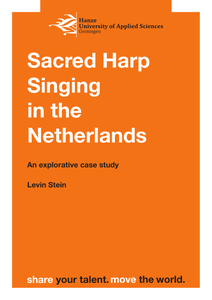This study employed an exploratory approach by applying practice theory to insights gathered throughthe triangulation of interview, document analysis and observation methodologies to 1) map the SacredHarp Singing practice scope and give a nuanced picture of its performativity in the Netherlands, witha particular focus on the Sacred Harp group from Amsterdam comparing it to one from Bremen and 2)investigate the underlying rise of transformative emotions, the social, secular, and religious meanings, andthe sense of belonging to an international community. The findings suggest that Sacred Harp enthusiastsin the region are keen on retaining the legacies of the traditional singers by establishing similar singingatmospheres and by following the practice’s historical customs and practices, including the communalsinging in the “hollow square” and the affinity towards democratic participation. The findings alsoindicate that while there is a noticeable level of commitment and excitement among local enthusiasts,the growth of the groups’ memberships is hampered by a lack of interest by the general public, possiblyin connection with insufficient strategies for publicizing the practice. Therefore, the existence of thesebarriers could imply that the practice would probably grow at a relatively slow pace in the region.
DOCUMENT

This book seeks to communicate what we learned, what I learned, in the hope that readers (particularly musicians in training) can find ways to learn for themselves as they challenge themselves to try new, and different, things.
DOCUMENT

This publication is a result of an international research project which took place from 2012-2014. Among the participators were four universities, number of service providers, NGOs and people with psychiatric and learning disabilities from Amersfoort and Maastricht in the Netherlands, Budapest in Hungary and Tallinn in Estonia. The aim of the project was to explore the wishes and needs of persons with psychiatric or learning difficulties with regard to community participation, and how services could be (more) supportive in order to meet these needs. We also looked at local policies, especially from the perspective of the UN Convention on the Rights of Persons with Disabilities (CRPD). From the research we learn that regardless of the country where people live, persons with disabilities have similar struggles to cope with vulnerability and deprivation. They also share the same desires as any other human being: the wish to live a good and valued life, to have meaningful activities and to belong to a social community. The stories in this book were selected from the interviews which were conducted by researchers during the project. The portraits illustrate experiences of illness, disability and recovery. They also reflect experiences of using social- and mental health services, exclusion and inclusion. By reading these stories we see, how multifaceted life can be, and what are the challenges towards the real participation in community
DOCUMENT

This publication gives an account of the Public Annotation of Cultural Heritage research project (PACE) conducted at the Crossmedialab. The project was carried out between 1 January 2008 and 31 December 2009, and was funded by the Ministry of Education, Culture, and Science. Three members of the Dutch Association of Science Centres (Vereniging Science Centra) actively participated in the execution of the project: the Utrecht University Museum, the National Museum of Natural History (Naturalis), and Museon. In addition, two more knowledge institutes participated: Novay and the Utrecht University of Applied Sciences. BMC Consultancy and Manage¬ment also took part in the project. This broad consortium has enabled us to base the project on both knowledge and experience from a practical and scientific perspective. The purpose of the PACE project was to examine the ways in which social tagging could be deployed as a tool to enrich collections, improve their acces¬sibility and to increase visitor group involvement. The museums’ guiding question for the project was: ‘When is it useful to deploy social tagging as a tool for the benefit of museums and what kind of effect can be expected from such deployment?’ For the Crossmedialab the PACE project presented a unique opportunity to conduct concrete research into the highly interesting phenomenon of social tagging with parties and experts in the field.
DOCUMENT
